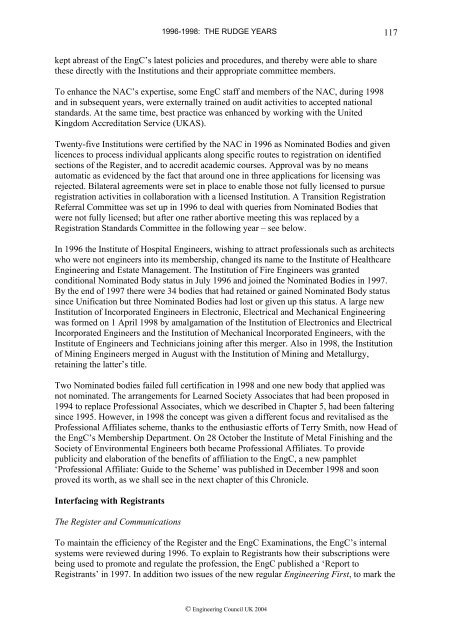An Engine for Change - A Chronicle of the Engineering Council
An Engine for Change - A Chronicle of the Engineering Council
An Engine for Change - A Chronicle of the Engineering Council
You also want an ePaper? Increase the reach of your titles
YUMPU automatically turns print PDFs into web optimized ePapers that Google loves.
1996-1998: THE RUDGE YEARS 117kept abreast <strong>of</strong> <strong>the</strong> EngC’s latest policies and procedures, and <strong>the</strong>reby were able to share<strong>the</strong>se directly with <strong>the</strong> Institutions and <strong>the</strong>ir appropriate committee members.To enhance <strong>the</strong> NAC’s expertise, some EngC staff and members <strong>of</strong> <strong>the</strong> NAC, during 1998and in subsequent years, were externally trained on audit activities to accepted nationalstandards. At <strong>the</strong> same time, best practice was enhanced by working with <strong>the</strong> UnitedKingdom Accreditation Service (UKAS).Twenty-five Institutions were certified by <strong>the</strong> NAC in 1996 as Nominated Bodies and givenlicences to process individual applicants along specific routes to registration on identifiedsections <strong>of</strong> <strong>the</strong> Register, and to accredit academic courses. Approval was by no meansautomatic as evidenced by <strong>the</strong> fact that around one in three applications <strong>for</strong> licensing wasrejected. Bilateral agreements were set in place to enable those not fully licensed to pursueregistration activities in collaboration with a licensed Institution. A Transition RegistrationReferral Committee was set up in 1996 to deal with queries from Nominated Bodies thatwere not fully licensed; but after one ra<strong>the</strong>r abortive meeting this was replaced by aRegistration Standards Committee in <strong>the</strong> following year – see below.In 1996 <strong>the</strong> Institute <strong>of</strong> Hospital <strong>Engine</strong>ers, wishing to attract pr<strong>of</strong>essionals such as architectswho were not engineers into its membership, changed its name to <strong>the</strong> Institute <strong>of</strong> Healthcare<strong>Engine</strong>ering and Estate Management. The Institution <strong>of</strong> Fire <strong>Engine</strong>ers was grantedconditional Nominated Body status in July 1996 and joined <strong>the</strong> Nominated Bodies in 1997.By <strong>the</strong> end <strong>of</strong> 1997 <strong>the</strong>re were 34 bodies that had retained or gained Nominated Body statussince Unification but three Nominated Bodies had lost or given up this status. A large newInstitution <strong>of</strong> Incorporated <strong>Engine</strong>ers in Electronic, Electrical and Mechanical <strong>Engine</strong>eringwas <strong>for</strong>med on 1 April 1998 by amalgamation <strong>of</strong> <strong>the</strong> Institution <strong>of</strong> Electronics and ElectricalIncorporated <strong>Engine</strong>ers and <strong>the</strong> Institution <strong>of</strong> Mechanical Incorporated <strong>Engine</strong>ers, with <strong>the</strong>Institute <strong>of</strong> <strong>Engine</strong>ers and Technicians joining after this merger. Also in 1998, <strong>the</strong> Institution<strong>of</strong> Mining <strong>Engine</strong>ers merged in August with <strong>the</strong> Institution <strong>of</strong> Mining and Metallurgy,retaining <strong>the</strong> latter’s title.Two Nominated bodies failed full certification in 1998 and one new body that applied wasnot nominated. The arrangements <strong>for</strong> Learned Society Associates that had been proposed in1994 to replace Pr<strong>of</strong>essional Associates, which we described in Chapter 5, had been falteringsince 1995. However, in 1998 <strong>the</strong> concept was given a different focus and revitalised as <strong>the</strong>Pr<strong>of</strong>essional Affiliates scheme, thanks to <strong>the</strong> enthusiastic ef<strong>for</strong>ts <strong>of</strong> Terry Smith, now Head <strong>of</strong><strong>the</strong> EngC’s Membership Department. On 28 October <strong>the</strong> Institute <strong>of</strong> Metal Finishing and <strong>the</strong>Society <strong>of</strong> Environmental <strong>Engine</strong>ers both became Pr<strong>of</strong>essional Affiliates. To providepublicity and elaboration <strong>of</strong> <strong>the</strong> benefits <strong>of</strong> affiliation to <strong>the</strong> EngC, a new pamphlet‘Pr<strong>of</strong>essional Affiliate: Guide to <strong>the</strong> Scheme’ was published in December 1998 and soonproved its worth, as we shall see in <strong>the</strong> next chapter <strong>of</strong> this <strong>Chronicle</strong>.Interfacing with RegistrantsThe Register and CommunicationsTo maintain <strong>the</strong> efficiency <strong>of</strong> <strong>the</strong> Register and <strong>the</strong> EngC Examinations, <strong>the</strong> EngC’s internalsystems were reviewed during 1996. To explain to Registrants how <strong>the</strong>ir subscriptions werebeing used to promote and regulate <strong>the</strong> pr<strong>of</strong>ession, <strong>the</strong> EngC published a ‘Report toRegistrants’ in 1997. In addition two issues <strong>of</strong> <strong>the</strong> new regular <strong>Engine</strong>ering First, to mark <strong>the</strong>© <strong>Engine</strong>ering <strong>Council</strong> UK 2004
















